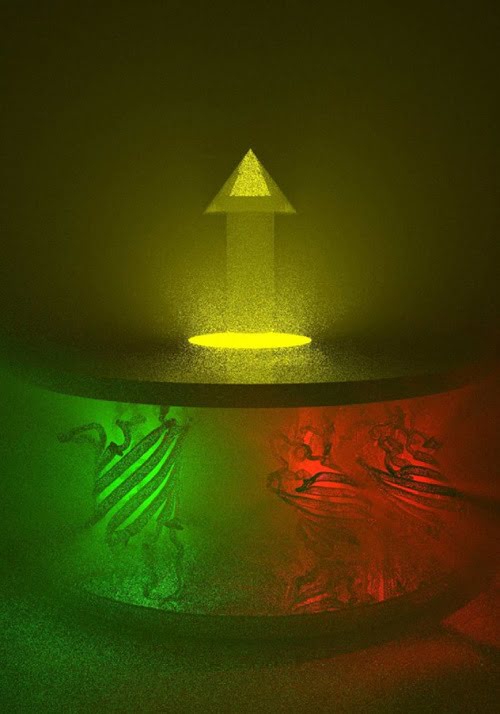A polariton laser based on lab-grown, fluorescent jellyfish proteins could impact the fabrication of artificial optical devices, advance the field of optical computing — as it requires less energy than conventional lasers — and aid in new biomedical applications serving as a bio-compatible, bio-implantable light source of sorts.

Schematic illustration of a fluorescent protein polariton laser in action. Particles made from a mixture of light and electronic energy are created in a film of green fluorescent protein produced by live cells. The particles can synchronize each other to form a leaky condensate, with the leakage being a bright beam of laser-like light. Courtesy of Dietrich/Gather, University of St Andrews.
The green fluorescent protein (GFP) found in the pacific jellyfish Aequorea Victoria is the energy acceptor in the natural bioluminescence of the animal. By isolating the section of the DNA that tells the cellular machinery of the jellyfish how to produce GFP and then genetically engineering the DNA, researchers at Scotland’s University of St. Andrews have created a polariton (jellyfish) laser; their laser is different in physics from conventional lasers and also potentially more efficient at generating light at low energy levels.
Malte Gather, a professor at the University of St. Andrews, told Photonics Media their invention was inspired by nature.
“The work was inspired by the discovery that nature may have optimized — with subnanometer precision — the size of the molecules driving the bioluminescence of jellyfish to allow them to shine as brightly as possible,” he said. “We have calculated that the green fluorescent protein molecule — the molecule allowing certain jellyfish to emit bright green light — has just the right size to strike an optimal balance between not losing energy to unproductive quenching and being able to squeeze as many molecules as possible into the light-emitting cells of the animal.”
Previously, polariton lasers have been proven to be unsuitable for real-world applications because of the cryogenic temperatures they require to work effectively. However, the St. Andrews GFP polariton laser can be operated at room temperature.
“Organic materials hold great potential in this context as they provide extremely robust polaritons at ambient conditions. Whilst previous work required complex synthetic chemistry to obtain these materials and necessitated sophisticated sub-10 ps pump sources to drive them, we now demonstrate a polariton laser based on GFP that can be run using a much simpler nanosecond pump source,” said Gather. “Our approach is not only simpler; the protein polariton laser also shows better performance as the light emitting part of the protein molecule is protected by a naturally produced nanometer sized natural shell.”
The University of St. Andrews protein polariton lasers currently emit in the green part of the spectrum. However, Gather said there are other fluorescent proteins emitting in the blue and the red part of the spectrum, so it is conceivable that there will soon be protein polariton lasers covering the entire visible spectrum.
Beyond using GFP and other fluorescent proteins, studying their structure and optical properties could have further photonics applications such as improving artificial emitter materials such as colloidal quantum dots and organic semiconductors.
“This is beyond the point of just being hypothesized,” Gather said. “We have demonstrated that one can make a polariton laser based on fluorescent proteins. What we haven’t done yet is to use the laser to do anything. For the optical computing applications, I expect that we’ll be able to see proof-of-principle demonstrations within the next four to five years. The same timescale is probably true for the bio-applications, while it could be another half-decade after that until people start to use this as a tool.”
The research has been published in the journal Science Advances (doi: 10.1126/sciadv.1600666).